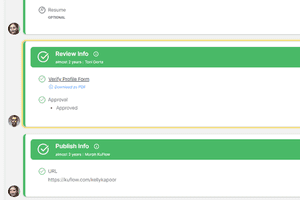Workflow Management: Automation vs. Orchestration
Published 24-04-2023 by Hector Tessari - KuFlow Team

Credits: Created by lexica.art - Edited by Hector Tessari
As developers, we constantly search for ways to optimize our workflows and enhance our code. As businesses strive for greater efficiency and cost reduction in the workplace, they have increasingly adopted automation and orchestration to streamline their workflows. However, what are these terms, and how can we, as developers, contribute to this digital transformation?
Workflow Automation
Workflow automation is the process of automating individual tasks within a larger workflow. For example, we can automate the process of triaging bug reports by utilizing tools like Jira or Trello. This can save us time and resources while reducing the chance of errors.
One real-life example of workflow automation can be seen in the healthcare industry. Hospitals and clinics can automate the process of scheduling appointments and sending reminders to patients. In addition, the financial industry can automate the process of loan approval, reducing the amount of time it takes to approve a loan while decreasing the likelihood of errors.
As developers, we can build and implement the necessary software to automate these processes, ensuring accuracy and efficiency.
Workflow Orchestration
Workflow orchestration is the process of managing a complex workflow by automating and coordinating individual tasks. This can be particularly useful in industries that require a lot of coordination between different departments or teams.
One example of workflow orchestration can be found in the software development industry. Workflow orchestration can help manage the various tasks involved in developing a new software product, such as coding, testing, and deployment. By automating the process of code testing and deployment, workflow orchestration can ensure that the final product is error-free and delivered on time.
Combining Automation and Orchestration
While automation and orchestration can be useful on their own, combining the two can create an even more efficient workflow system. Let's consider some real examples of how automation and orchestration can be combined to optimize workflows in different industries.
In the logistics industry, companies can use workflow orchestration to manage the entire shipping process, from receiving orders to delivering goods to customers. By automating individual tasks, such as tracking shipments and updating delivery statuses, and orchestrating the overall workflow, logistics providers can ensure that goods are delivered to customers in a timely and cost-effective manner.
Similarly, in the education industry, schools and universities can use workflow orchestration to manage the student enrollment process, from admission to graduation. By automating tasks such as course registration and grade processing, and orchestrating the overall workflow, educational institutions can ensure that students have a seamless and efficient academic journey.
Furthermore, in the retail industry, companies can use workflow orchestration to manage the entire supply chain process, from sourcing raw materials to delivering finished products to stores. By automating individual tasks, such as inventory management and quality control, and orchestrating the overall workflow, retailers can ensure that they meet customer demand while minimizing waste and costs.
By combining automation and orchestration, businesses in various industries can optimize their workflows, reduce errors, save time and resources, and ultimately improve their bottom line. As developers, who play a crucial role in this digital transformation, let's seize this opportunity and contribute to the success of our respective industries.

KuFlow: Your Workflow Management Solution
Active participation by developers is critical in the digital transformation of workflows. KuFlow is a platform that can aid in this transformation. KuFlow provides a comprehensive workflow management solution that integrates automation and orchestration capabilities. With KuFlow, we can design, automate, and monitor our workflows while integrating with your in-house applications, developments, third-party software, or RPA solutions ensuring accuracy and efficiency.
In conclusion, developers have an important role to play in the digital transformation of workflows. By leveraging the latest advancements in workflow management and tools like KuFlow, businesses can optimize code, improve workflows, and ultimately contribute to the overall efficiency and effectiveness of their businesses.





